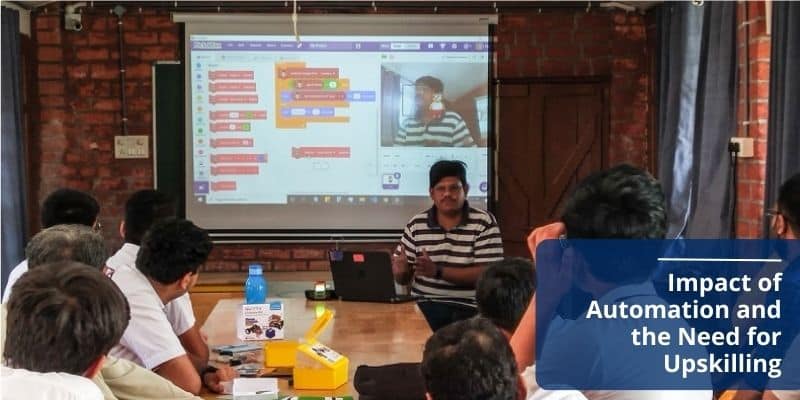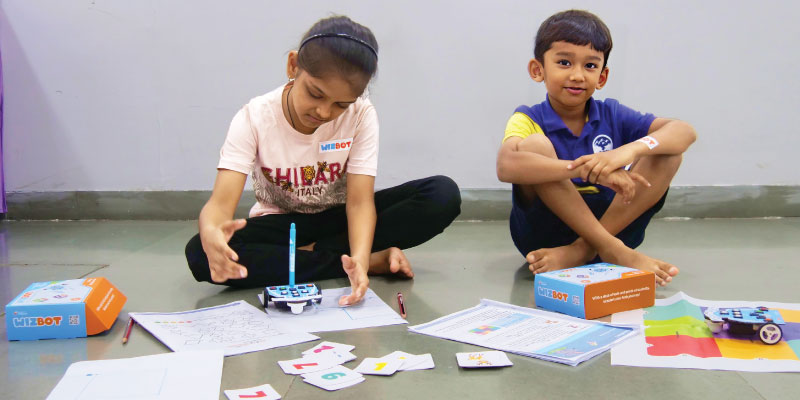Rapid technological advancements are reshaping industries such as healthcare, travel, communication, and education. Among the valuable resources available, robotics skills have emerged as powerful tools in the field of education. Its integration into the learning environment has showcased its effectiveness in both general and specialized education.
By harnessing the potential of robotics skills for students, educators can prepare students for the challenges of the future, equipping them with the skills and knowledge needed to thrive in an ever-evolving world. Read on this blog as we will discuss how robotics can be used in education to equip students.
The Impact of Robotics Skills on the Future Workforce
Increased Employability: The acquisition of robotics skills enhances an individual’s employability by opening up opportunities in various industries. For example, manufacturing industry relies heavily on robotics for automation and streamlining production processes, healthcare institutions are adopting robotic technologies for tasks such as surgery, patient care, and rehabilitation,
Logistics and technology sectors also require robotics expertise for tasks like warehouse automation, autonomous vehicles, and AI-driven systems. By developing robotics skills, individuals position themselves as valuable assets in the job market, increasing their employability across multiple industries.
Technological Adaptability: Robotics skills indicate an individual’s ability to adapt to new technologies, which is crucial in a rapidly evolving workplace. Technology is advancing at an unprecedented pace, and companies are constantly incorporating robotics and automation into their operations.
By acquiring robotics skills, individuals demonstrate their capacity to learn and work with cutting-edge technologies, making them more versatile and adaptable employees.
Collaboration and Teamwork: Robotics projects often require collaboration and teamwork, fostering essential skills for future work environments. Many robotics applications involve multidisciplinary teams working together to design, build, and program robotic systems.
These projects demand effective communication, coordination, and cooperation among team members with diverse backgrounds and expertise.
Adapting to Industry 4.0: Proficiency in robotics skills aligns individuals with the demands of Industry 4.0, where robotics and automation play a central role. Industry 4.0 refers to the current trend of integrating advanced technologies, such as robotics, artificial intelligence, Internet of Things (IoT), and big data analytics, into manufacturing and other industries. The fourth industrial revolution requires a workforce that can effectively leverage these technologies to enhance productivity, efficiency, and innovation.
The Evolving Job Market and the Increasing Demand for Professionals with Robotics Skills
The job market is evolving, and there is a growing demand for professionals with robotics skills. Let’s discuss few of the key points :
- Automation and Robotics: The job market demands professionals who can design, program, operate, and maintain robotic systems as industries increasingly adopt automation and robotics technologies.
- Enhanced Efficiency and Cost-effectiveness: Organizations seek professionals with robotics skills to optimize processes, reduce manual labor, and achieve better efficiency and cost-effectiveness.
- Emerging Fields: Robotics is expanding into healthcare, agriculture, logistics, and customer service, creating a demand for skilled professionals to develop innovative solutions in these domains.
- Future-proofing Careers: Robotics skills provide a competitive edge and increase employability in an evolving job market disrupted by automation.
- Interdisciplinary Nature: Robotics combines engineering, computer science, mathematics, and physics, equipping professionals with a diverse skill set to tackle complex problems and contribute across domains.
Overall building robotics skills can open up exciting opportunities in a range of industries and ensure individuals remain relevant in the evolving job market.
The Potential Impact of Automation on Traditional Jobs and the Need for Upskilling
Automation has the potential to revolutionize the job market, impacting traditional roles and creating a need for upskilling. While it may displace certain jobs, it also opens up new opportunities for those who are prepared. To thrive in this automated era, individuals must acquire the necessary skills and adapt to changing demands.
Here are few of the key points to consider:
- Job Displacement: Automation technologies can replace repetitive tasks, leading to job displacement in industries like manufacturing and customer service.
- Shift in Job Roles: While automation may eliminate certain jobs, it simultaneously creates new opportunities. Upskilling allows individuals to acquire the skills needed for emerging roles, such as data analysts, AI specialists, and automation engineers.
- Upskilling for Resilience: To adapt to the changing job market, individuals must invest in upskilling. This involves acquiring new technical skills, such as programming or machine learning, to complement existing expertise and remain competitive.
- Soft Skills: While technical skills are important, the demand for soft skills like creativity, critical thinking, and adaptability is increasing. These skills are difficult to automate and highly valued in jobs requiring human interaction and complex decision-making.
- Lifelong Learning: Continuous education and skill development are vital in an automated economy. Embracing a mindset of lifelong learning ensures individuals stay adaptable and relevant in the face of evolving job requirements.
By acquiring these skills individuals can navigate the changing job landscape and remain competitive in an automated economy.
Integrating Robotics into the Education System
Integrating robotics into education revolutionizes learning, equipping students with essential future-ready skills. Robotics plays a pivotal role in modern education, providing hands-on experience that fosters creativity, collaboration, and innovation. It enhances understanding of STEM subjects and cultivates a passion for learning. Through robotics, students develop adaptability, perseverance, and technical proficiency, preparing them for a technology-driven world. Embracing robotics in education empowers students to thrive in diverse careers.
Different Approaches and Strategies for Incorporating Robotics into Schools
Incorporating robotics into schools involves several approaches and strategies to enhance student’s learning experiences. Here are some key methods:
- Robotics Clubs and Activities: Establishing robotics clubs or extracurricular activities allow students to explore robotics in a fun and interactive way. They can work in teams, build robots, and participate in competitions, fostering collaboration and problem-solving skills.
- Robotics Kits and Tools: Providing schools with robotics kits and tools enables hands-on learning. Students can assemble and program robots, gaining practical experience and understanding of robotics concepts.
- Integration into Curriculum: Integrating robotics into existing subjects, such as science, technology, engineering, and math (STEM), allows students to apply robotics principles to real-world scenarios. This interdisciplinary approach deepens their understanding of core subjects and promotes critical thinking.
- Coding and Programming: Teaching coding and programming languages, such as Scratch or Python, enables students to program robots and control their movements. This develops computational thinking and logical reasoning skills.
- Professional Development for Educators: Offering professional development opportunities, workshops, or training programs for teachers equips them with the knowledge and skills to effectively integrate robotics into their teaching practices.
By implementing these approaches and strategies, schools can create engaging learning environments, foster creativity, problem-solving, and equip students with the skills needed for the future workforce.
Robotics Courses Available for Skill Development of Students
There are several robotics programs and initiatives available for students to explore and enhance their robotics skills. Here is an overview of some popular options:
Coursera – University of Pennsylvania
Comprehensive 7-month online robotics course for beginners covering aerial robotics, quadrotor flying robot design, motion planning, and real-life robot applications. Hands-on exercises to reinforce learning and proficiency in Matlab.
STEMpedia – AI and Robotics with Quarky
Super beginner level robotics course suitable for 10-year-old children. Learn Robotics, AI & Machine Learning basics to create real-life projects such as line followers, AI delivery cars, assistant robots, and self-driving robots with block-based coding.
These programs and initiatives offer students opportunities to engage with robotics, learn programming skills, and develop problem-solving abilities. They foster creativity, teamwork, and a passion for STEM fields, preparing students for future careers in robotics and related industries.
NPTEL – IIT Bombay
Esteemed robotics course for beginners from Indian Institute of Technology, Bombay. Explores robotics technologies, industrial robots, trajectory planning, dynamics, control, and practical applications. Suitable for engineering students and professionals.
Udemy – Robotics for Beginners
Beginner-friendly robotics course with a practical “learn-by-doing” approach. No prior electronics knowledge required, but basic mathematics helpful. Covers electronics, circuit-making, servo motor control, and fundamentals of robotics.
FutureLearn – University of Reading
Freshers’ four-week beginner robotics course providing an overview of robot types, applications, and historical context. Focus on technical aspects and problem-solving, with weekly progress assessments.
In a Nutshell
Robotics skills in education are crucial for preparing students for the future workforce. These skills enhance employability, adaptability, and collaboration. The evolving job market demands robotics expertise, and upskilling is essential to thrive in an automated world.
Integrating robotics through clubs, hands-on activities, coding, and interdisciplinary approaches fosters creativity and critical thinking. Equipping students with robotics skills empowers them to lead in a technology-driven future, contributing to innovation and progress across industries.












